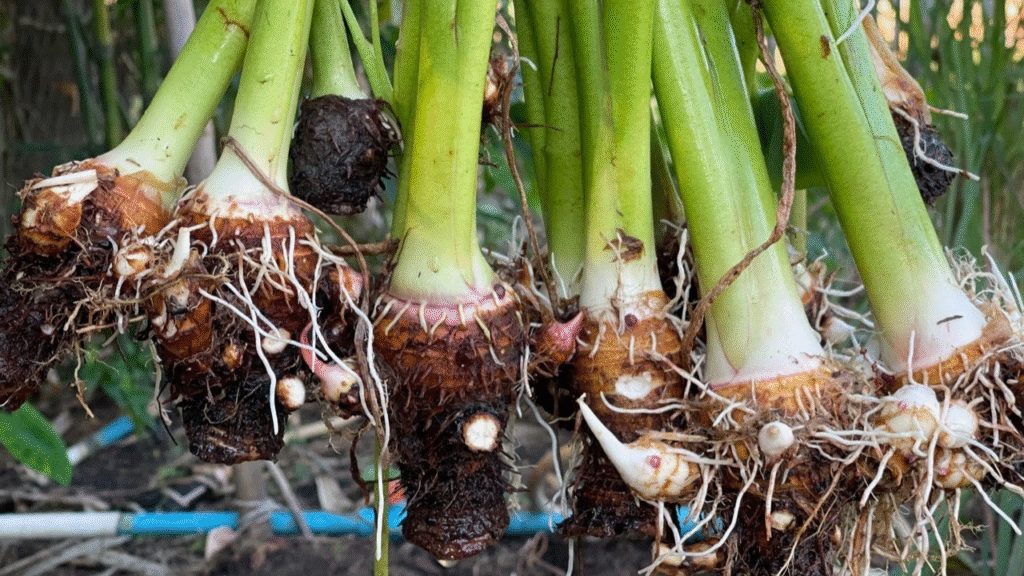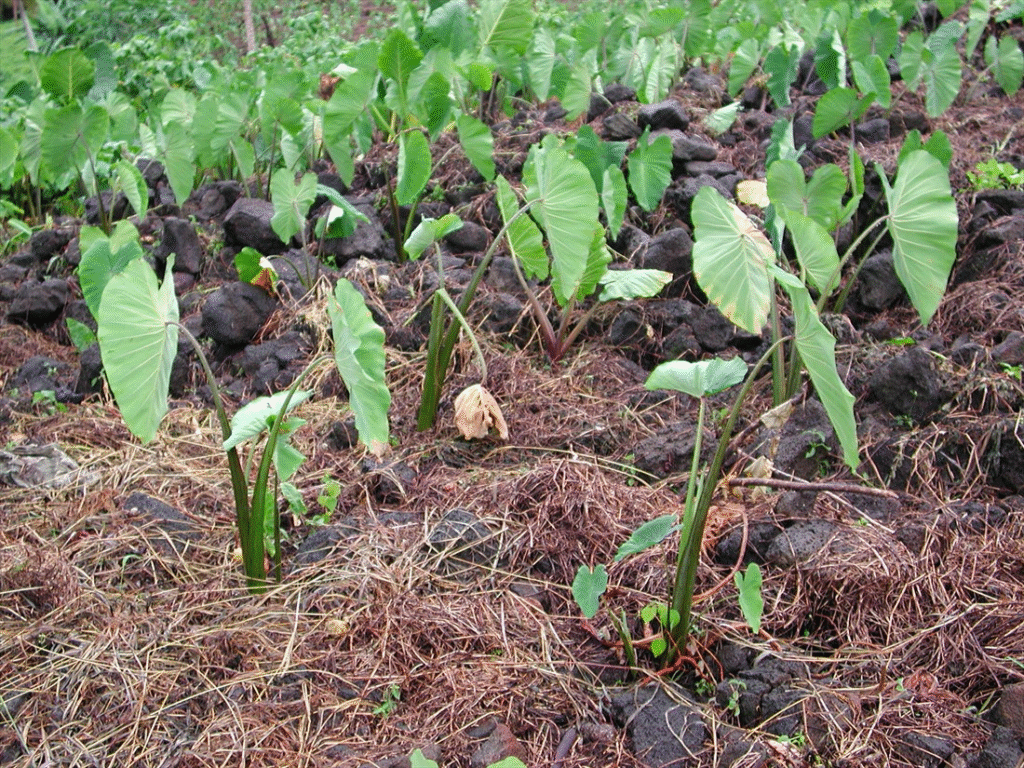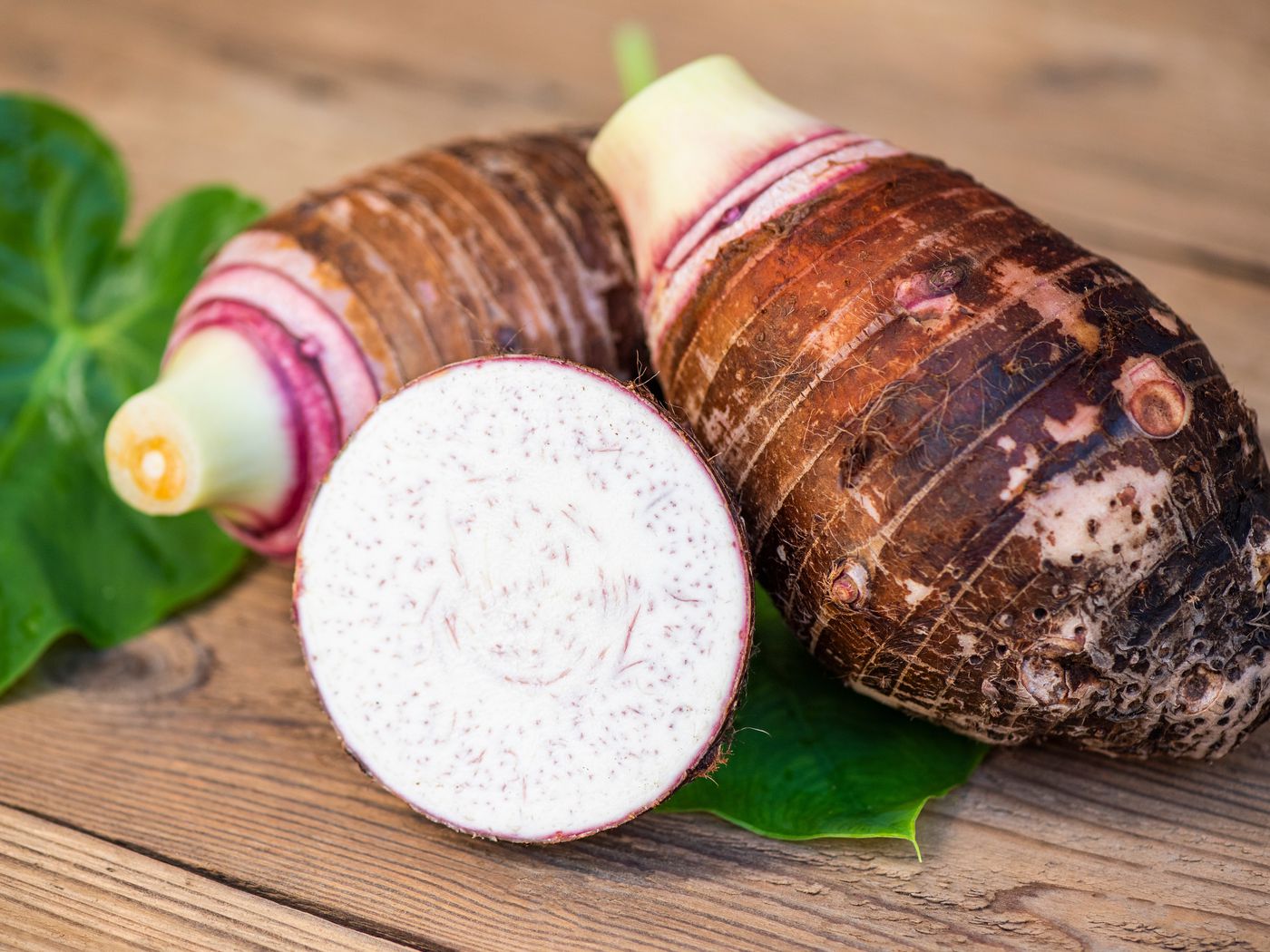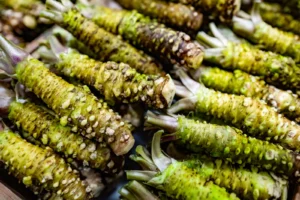How to Grow and Use Taro: Complete Guide for Home Gardeners
Are you looking to grow your own taro, the versatile tropical root vegetable that’s growing in popularity across the US? Whether you have a spacious garden, a small balcony for pots, or just a sunny windowsill, taro (Colocasia esculenta) can be a rewarding addition to your home-grown produce. This comprehensive guide will walk you through everything you need to know about growing and using this nutritious crop.
What is Taro?
Taro is an ancient root vegetable that has been cultivated for over 5,000 years. Originally from Southeast Asia, it has become an important staple food in many cuisines worldwide, including Hawaiian, Pacific Islander, Caribbean, and various Asian cultures. In the US market, taro is gaining popularity both as a food crop and as an ornamental plant with its stunning elephant ear-like leaves.
The plant produces large, heart-shaped leaves on long stems and develops an underground corm (similar to a tuber) that is the primary edible portion. Some varieties also have edible stems and leaves when properly prepared.
Taro Growing Requirements
Before diving into the growing process, let’s understand what taro plants need to thrive:
| Requirement | Details |
|---|---|
| USDA Hardiness Zones | 8-11 (outdoor year-round growth) |
| Light | Full sun to partial shade (6-8 hours of sunlight) |
| Soil | Rich, moist, well-draining with high organic content, pH 5.5-6.5 |
| Water | Consistent moisture; can tolerate wet conditions |
| Temperature | Warm temperatures 70-85°F (21-29°C) |
| Growing Season | 200-250 days to reach full maturity |
| Spacing | 2-3 feet between plants |
| Planting Depth | 2-3 inches for corms |
How to Grow Taro in Your Garden
Growing taro in your garden is straightforward if you live in a suitable climate. Follow these steps for successful cultivation:

Preparing Your Garden Space
- Select a suitable location: Choose a spot that receives at least 6 hours of sunlight daily, preferably with some afternoon shade in hotter regions.
- Prepare the soil: Taro thrives in rich, moist soil. Work in plenty of compost or well-rotted manure to improve soil structure and fertility. According to the USDA Natural Resources Conservation Service, maintaining good soil health is crucial for growing tropical crops like taro.
- Create a proper growing bed: Consider creating slightly sunken beds to help retain moisture, especially if you’re in a drier climate.
Planting Taro Outdoors
- When to plant: Wait until all danger of frost has passed and soil temperatures reach at least 70°F (21°C).
- Prepare your planting material: You can plant small whole corms or larger corms cut into sections (each with at least one growing bud). Allow cut pieces to dry for 24 hours before planting to reduce the risk of rotting.
- Planting technique: Plant corms 2-3 inches deep, with the growing buds pointing upward. Space plants 2-3 feet apart as they can grow quite large.
- Initial care: Water thoroughly after planting and apply a layer of mulch to retain moisture and suppress weeds.
Ongoing Care for Garden Taro
- Watering: Keep the soil consistently moist. Taro loves water and can even be grown in boggy conditions or areas that occasionally flood.
- Fertilizing: Apply a balanced organic fertilizer every 4-6 weeks during the growing season. Taro is a heavy feeder.
- Mulching: Maintain a thick layer of organic mulch around plants to conserve moisture and add nutrients as it breaks down.
- Pest management: Watch for aphids, spider mites, and leaf rollers. In most home gardens, these can be controlled with organic methods like neem oil or insecticidal soap.
How to Grow Taro in Pots
Don’t have garden space? No problem! Taro grows surprisingly well in containers if given the right conditions:
Selecting and Preparing Containers
- Choose the right pot: Select a large container at least 16-18 inches in diameter and equally deep. Ensure it has drainage holes.
- Prepare the container: Fill with a rich potting mix enhanced with compost. You can create a custom mix with equal parts potting soil, compost, and coconut coir for excellent moisture retention.
- Positioning: Place your container where it will receive appropriate sunlight based on your climate—more sun in cooler areas, partial shade in hotter regions.
Planting and Care for Potted Taro
- Planting depth: Plant your taro corm 2-3 inches below the soil surface.
- Watering: Container-grown taro requires frequent watering. Check soil moisture daily during hot weather. Consider placing a saucer under your pot to catch excess water that the plant can reabsorb.
- Fertilizing: Apply a liquid fertilizer every 2-3 weeks during the growing season at half the recommended strength.
- Winter care: In zones below 8, bring containers indoors before temperatures drop below 60°F (15°C). Place near a bright window and reduce watering slightly during dormancy.
Growing Taro Indoors
Yes, you can grow taro as a houseplant! While indoor plants may not produce large edible corms, they make stunning ornamental specimens with their dramatic foliage.
Indoor Growing Requirements
- Light: Place near your brightest window, ideally with eastern or southern exposure. Supplement with grow lights during winter months if necessary.
- Container: Choose a pot at least 12 inches in diameter with good drainage.
- Soil: Use a rich, well-draining potting mix with added perlite to prevent compaction.
- Humidity: Taro loves humidity. Place on a pebble tray with water, use a humidifier nearby, or group with other plants to increase ambient moisture.
Care and Maintenance for Indoor Taro
- Watering: Keep soil consistently moist but never soggy. Water thoroughly when the top inch of soil begins to dry.
- Fertilizing: Apply a half-strength balanced houseplant fertilizer monthly during the growing season.
- Temperature: Maintain indoor temperatures between 65-85°F (18-29°C). Avoid cold drafts and air conditioning vents.
- Cleaning: Wipe leaves occasionally with a damp cloth to remove dust and keep pests at bay.

How to Grow Taro from Seed
While most taro is propagated from corms, growing from seeds is possible but uncommon. Here’s how to do it:
- Obtaining seeds: Taro seeds can be difficult to find commercially. You may need to purchase from specialty suppliers or collect them from a flowering taro plant.
- Seed preparation: Soak seeds in warm water for 24 hours before planting to improve germination.
- Planting medium: Use a sterile seed-starting mix in small pots or trays with drainage.
- Planting depth: Plant seeds approximately 1/4 inch deep and cover lightly with soil.
- Environmental conditions: Maintain temperatures of 75-85°F (24-29°C) and high humidity by covering with plastic until germination.
- Germination time: Expect germination in 2-3 weeks under optimal conditions.
- Transplanting: Once seedlings have 2-3 true leaves, transplant to individual pots with regular potting soil.
Harvesting and Storing Taro
Patience is key when growing taro—most varieties take 7-10 months to reach harvestable size.
When and How to Harvest
- Timing: Taro is typically ready to harvest when the leaves begin to yellow and die back naturally, usually 7-10 months after planting.
- Harvesting technique: Carefully dig around the plant with a garden fork, starting about a foot away from the stem. Gently lift the main corm and attached cormels (baby corms).
- Cleaning: Rinse off excess soil but don’t scrub the corms, as this could damage the protective skin.
Storing Your Harvest
- Short-term storage: Unwashed corms can be stored in a cool, dry place for 1-2 weeks.
- Long-term storage: For longer storage, keep corms in a cool (around 50°F/10°C), humid environment, similar to how you would store potatoes.
- Preparing for cooking: Remember that taro contains calcium oxalate crystals that can cause skin irritation. Always wear gloves when handling cut taro and thoroughly cook before eating.
Growing Taro for the US Market
If you’re considering growing taro commercially in the US, here are some important considerations:
- Market potential: The US market for taro is growing, particularly in areas with large Asian, Pacific Islander, and Caribbean communities.
- Commercial varieties: ‘Bun Long’ and ‘Lehua’ are popular commercial varieties in the US.
- Organic certification: Consider obtaining USDA organic certification, as there’s increasing demand for organically grown taro. Visit the USDA Organic Program website for more information on certification requirements.
- Value-added products: Beyond selling fresh corms, consider processing taro into chips, flour, or frozen products to expand your market opportunities.
- Local regulations: Check with your state’s department of agriculture regarding any specific regulations for growing taro, especially in states like Hawaii where taro has cultural significance.

Common Problems When Growing Taro
Even with proper care, you might encounter some challenges when growing taro:
Disease Management
- Phytophthora Leaf Blight: This fungal disease causes water-soaked spots on leaves. Remove affected leaves and improve air circulation.
- Root Rot: Caused by overwatering or poor drainage. Ensure your soil drains well and avoid waterlogged conditions.
- Dasheen Mosaic Virus: Watch for yellow mottling on leaves. There’s no cure, so remove and destroy infected plants to prevent spread.
Pest Control
- Aphids: These small insects can cluster on the undersides of leaves. Control with insecticidal soap or a strong spray of water.
- Spider Mites: Tiny pests that cause stippling on leaves. Increase humidity and treat with neem oil.
- Taro Beetles: These can damage corms. Practice crop rotation and maintain clean garden practices.
Conclusion
Growing taro can be a rewarding experience whether you’re looking to harvest the nutritious corms or simply enjoy the stunning tropical foliage. By providing the right growing conditions—warm temperatures, consistent moisture, and rich soil—you can successfully cultivate this ancient crop in your garden, in containers, or even indoors.
As interest in diverse, nutritious foods continues to grow in the US market, taro represents an excellent opportunity for home gardeners and small-scale farmers alike. With proper planning and care, you can enjoy this versatile crop that has sustained cultures around the world for thousands of years.
Remember that while taro requires some specific growing conditions, the versatility of the plant means there’s likely a method that will work for your particular situation.






